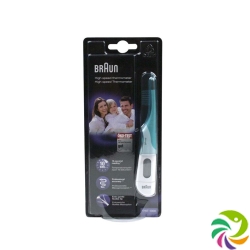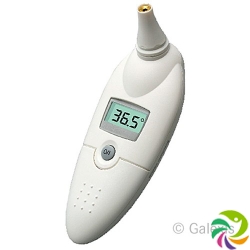Choosing the Best Infant Thermometer: Rectal, Ear, or Forehead?

Babies are especially vulnerable to temperature changes, and even a mild fever may be a sign of an underlying illness that needs immediate attention. Parents have to have dependable tools to successfully screen their infant's temperature. With different thermometers available, such as rectal, ear and forehead, it could be difficult to choose the best option. Each type of thermometer has its advantages and limitations, and understanding these can help parents make an informed decision about the most appropriate method for his or her child.
Rectal Thermometer
Rectal thermometers are considered one of the most accurate infant thermometers, which work by carefully inserting them into the rectum, wherein they accurately measure the body's internal temperature. This direct contact with the core of the body makes rectal thermometers very dependable, especially for babies whose body temperature needs to be closely monitored. Pediatricians often recommend rectal thermometers as the gold standard for accurate dimension of rectal temperature in newborns and young children.
Advantages of a rectal thermometer:
- High accuracy: Rectal thermometers provide highly accurate readings, making them ideal for situations wherein accuracy is crucial, inclusive of whilst monitoring a fever in a newborn or sick child.
- Reliability: The fidelity and reliability of rectal thermometers make them a better choice for healthcare professionals as they can detect even slight changes in body temperature.
Cons of a rectal thermometer:
- Discomfort: One of the main disadvantages of rectal thermometers is the potential discomfort for the infant. Inserting a thermometer may be uncomfortable and might cause distress to the child, requiring parents to be gentle and careful.
- Invasive use: Rectal thermometers require careful dealing to keep away from harm. Parents need to comply with appropriate commands to make sure safe use, together with using lubricant and placing the thermometer handiest gently.
Thus, rectal thermometers are highly accurate and reliable devices for measuring temperature in babies. For example, with the Braun Age Precision thermometer, that is suitable for oral, rectal or underarm, you will get speedy and accurate results in just eight seconds with Age Precision technology.
Ear Thermometers (Tympanic Thermometers)
Infant ear thermometer, additionally known as tympanic thermometers, measure the temperature inside the ear canal by way of detecting the infrared heat emitted by means of the eardrum and surrounding tissues. The thermometer is gently inserted into the ear canal and the sensor captures the temperature inside seconds, offering a quick and non-invasive studying. This makes ear thermometers a popular choice for parents who want a quick and convenient manner to take their child's temperature.
Ear thermometers are usually accurate for babies older than six months due to the fact their ear canals are evolved sufficient to permit for accurate readings. However, several factors can have an effect on the accuracy of a child's ear thermometer:
- Earwax: Excess earwax can block the direction of the sensor and affect readings, resulting in erroneous outcomes. Cleaning your child's ears often can help ensure more reliable measurements.
- Improper placement: The placement of the thermometer is crucial to get an accurate reading. If the thermometer is incorrectly adjusted to the eardrum, it may not measure the temperature accurately. Parents should comply with the manufacturer's commands to make sure proper use.
- Baby's age: While ear thermometers may be used on infants older than six months, they'll not be as reliable on younger babies due to their smaller ear canals, which may make it difficult to area successfully.
Choosing the best infant ear thermometer
When choosing the best infant ear thermometer, parents have to keep in mind factors inclusive of ease of use, analyzing speed, and any extra capabilities which can improve accuracy, such as a pre-heated tip to reduce the effect of ambient temperature on readings. It's also helpful to choose a thermometer with a clear display and a reminiscence function to tune temperature modifications over time.
Pay attention to Bosotherm Medical, which is used to optimally measure the body temperature of kids and adults. However, it's also appropriate for measuring surface temperatures, such as temperature of a milk bottle, tub water or ambient temperature. Innovative infrared technology provides fast dimension in just one second. Hygienic protecting covers ensure particularly hygienic use.
Forehead Thermometers
Forehead thermometers, also known as temporal artery thermometers, measure temperature by scanning the surface of the forehead, especially the temporal artery. This artery is placed close to the surface of the skin and is a handy and accessible region for measuring body temperature. The thermometer uses infrared technology to detect the warmth radiated from the skin above the temporal artery, offering a brief and non-invasive reading. This approach is mainly attractive for infants, because it causes minimal discomfort and can be performed even as the child is sleeping.
With the 1Temp 3 in 1 thermometer, you may determine the temperature of people, liquids and objects contactlessly the use of infrared technology. Simple one-handed operation guarantees your protection and hygiene, and your remaining 34 measurements are saved at the measuring device. With the meter, you may measure the temperature in one second, and depending on your preference, the temperature may be displayed in Celsius or Fahrenheit.
Although forehead thermometers provide a quick and easy way to measure a baby's forehead temperature, there are several factors which can have an effect on their accuracy:
- Sweat: Moisture on the forehead can affect the thermometer's ability to measure temperature as it should be. Before measuring, it's far critical to make sure that the forehead is dry to keep away from false results.
- Incorrect placement: To get an accurate reading, the thermometer should be placed effectively, commonly moving across the forehead from the center to the temple. It is important to follow the manufacturer's instructions for correct results.
- Outdoor temperature: Ambient temperature can affect readings, so it is best to take measurements in a stable surroundings.
When deciding on the best forehead thermometer for infants, take into account features such as ease of use, speed, and additional features such as memory recall or a backlit display for low-light conditions. A reliable forehead thermometer should also have a wide measurement range and the capacity to provide consistent readings.
Disclaimer: This article consists of information about different types of infant thermometers and does not represent medical recommendations. Always seeking the recommendation of a pediatrician with any questions regarding the usage of the thermometer and your child's health.



